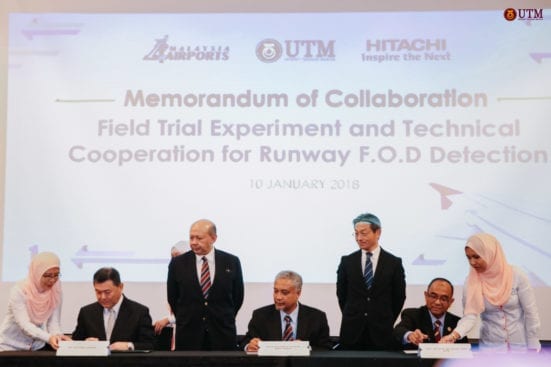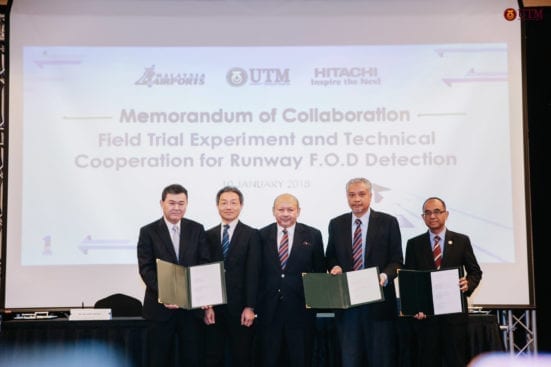
Sepang – Malaysia Airports continues to embrace advanced aviation technology by being the first airport in the world other than Narita International Airport to test the effectiveness of radio over fibre foreign object debris (FOD) detection system at Runway 2 in KL International Airport (KLIA). The technology is specifically called Linear-Cell Radar over Fibre FOD detection system. The installation of the new advanced system is a tripartite collaborative effort by Universiti Teknologi Malaysia (UTM), Hitachi Kokusai Electric (HiKE) and Malaysia Airports. The field trial is fully funded by the Ministry of Internal Affairs and Communications, Japan commencing from January 2018 over a three-year period until December 2020.
 According to Malaysia Airports managing director Datuk Badlisham Ghazali, KLIA is privileged to be selected as the site of the trial which puts KLIA on the map as an aviation technology innovator. “KLIA is among the world’s busiest airports with an average aircraft movement of 32,000 monthly. We are also the first airport in the region to have a three-independent runway system with runway length of 4 km. This advanced and first in the world radio over fibre technology will enhance the safety and surveillance measures of our runway thus strengthening KLIA’s position as regional hub,” he said.
According to Malaysia Airports managing director Datuk Badlisham Ghazali, KLIA is privileged to be selected as the site of the trial which puts KLIA on the map as an aviation technology innovator. “KLIA is among the world’s busiest airports with an average aircraft movement of 32,000 monthly. We are also the first airport in the region to have a three-independent runway system with runway length of 4 km. This advanced and first in the world radio over fibre technology will enhance the safety and surveillance measures of our runway thus strengthening KLIA’s position as regional hub,” he said.
KLIA was also selected due to its geographical suitability with its varied tropical weather in testing the robustness of the system. For Malaysia Airports, it is yet another innovation milestone as it is one of the earliest airports in Asia to install a high-end FOD detection system. This technology transfer initiative will also enhance Malaysian innovativeness as it will be the first system in Malaysia to use radio frequency within the 90GHz range. Among the many advantages of the system includes its low operational cost, low emission of radio waves, and most importantly a highly scalable system for busy airports.
Highly accurate and fast, the system is able to detect any FOD within the range of 500 meters in 10 seconds by using the Millimeter Wave Radar (MMW) over optical fibre technology. High resolution cameras are used to ensure high quality images. It also enables real-time data collection thus expediting the investigation process in identifying FOD sources and facilitating fast runway clearing process. This is crucial for efficient runway safety management. On top of this, the system will also be of great benefit in enhancing flight operations for our airline partners.
Badlisham also explained that KLIA’s selection as a suitable site was also thanks to the team at UTM, a leading expert in radio fibre technology and part of the research group at NICT, Japan for the past 5 years.
 Speaking on behalf of UTM, Prof. Datuk Ir. Dr. Wahid Omar, Vice-Chancellor of UTM, spoke of the university’s beliefs in Malaysians becoming innovators and creators of technology, and not merely consumers. He said that the university hopes to enhance the skills and technology expertise of the nation through this synergistic global engagement. “This Memorandum of Collaboration (MoC) can act as the catalyst for enhanced and sustained R&D based on first-class research activities, resulting in excellent and impactful outputs. It would not only contribute towards the growth and development of the linear cell radar technology, but would also nurture home-grown experts and researchers,” he commented further.
Speaking on behalf of UTM, Prof. Datuk Ir. Dr. Wahid Omar, Vice-Chancellor of UTM, spoke of the university’s beliefs in Malaysians becoming innovators and creators of technology, and not merely consumers. He said that the university hopes to enhance the skills and technology expertise of the nation through this synergistic global engagement. “This Memorandum of Collaboration (MoC) can act as the catalyst for enhanced and sustained R&D based on first-class research activities, resulting in excellent and impactful outputs. It would not only contribute towards the growth and development of the linear cell radar technology, but would also nurture home-grown experts and researchers,” he commented further.
The MoC was signed at Sama-Sama Hotel KLIA today. The various parties during the signing were represented by Prof. Datuk Ir. Dr. Wahid Omar, Vice-Chancellor of UTM, and Kaichiro Sakuma, president Chief Executive Officer and Board Director of HiKE and Mohd Suhaimi Abdul Mubin, Senior General Manager of Malaysia Airports. Present also at the ceremony was YAM Tan Sri Dato’ Seri Syed Anwar Jamalullail, Chairman of Malaysia Airports; Yoshiaki Takeuchi, Director General of Radio Department Telecommunication Bureau, Ministry of Internal Affairs and Communications, Japan; Professor Dr Sevia Md Idrus, FODDS Project Leader UTM; Raja Azmi Raja Nazuddin, Chief Financial Officer of Malaysia Airports; and Azli Mohamed, Chief Strategy Officer of Malaysia Airports.


